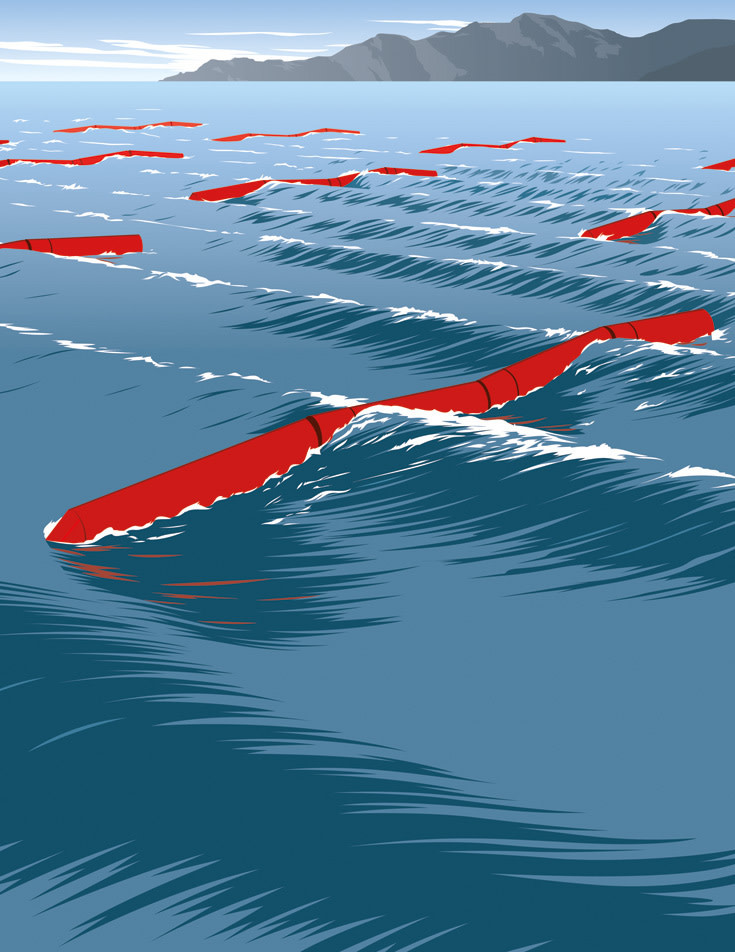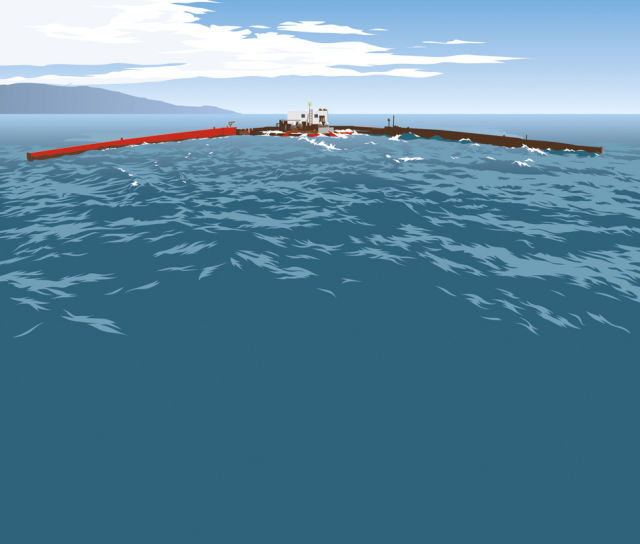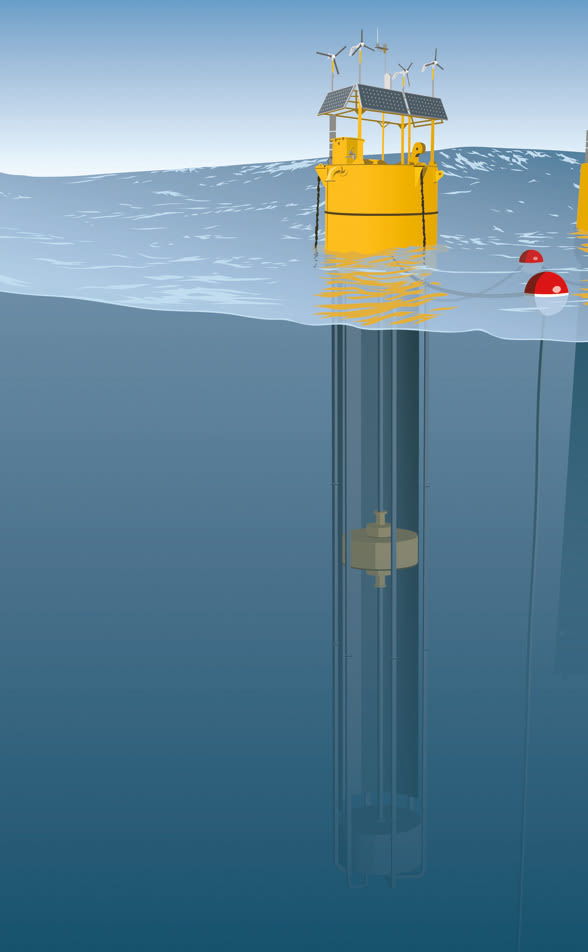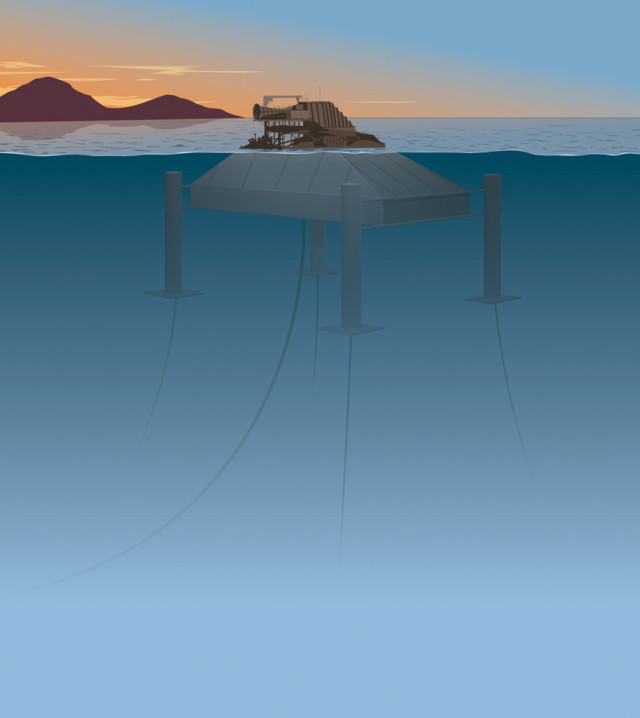Fathom This:

Image: Arthur Mount,Arthur Mount
THEY ARE STRANGE METAL CREATURES, bright red or yellow; one looks like a missile, another like a pair of outstretched wings. And one is so bizarre that you might say it resembles an oil platform topped with a gargantuan bullhorn. Outfitted with turbines and pistons, and moored to the ocean floor with heavy chains or columns of concrete and steel, each machine is designed for a single purpose: to capture the energy of ocean waves and turn it into clean, green electricity.
Just as wind energy companies battled during the 1970s to prove that their turbine designs were the very best at converting wind to usable electricity, some 50 companies now are vying to win the wave energy technology race. And in the United States, that battle is being waged right here, along the Oregon Coast.
“At some point, the oil and gas are going to run out,” says George Taylor, CEO of New Jersey-based Ocean Power Technologies. In April 2007, Taylor took his wave energy company to Wall Street, attracting investments of more than $90 million. Now Ocean Power Technologies is gunning to hook up one of its machines—which resemble huge navigational buoys—to the power grid in Reedsport by summer 2009. It also wants to build a power plant near Coos Bay that would produce enough electricity to power 30,000 homes.
Taylor’s company is one of six or so that have identified Oregon as an ideal place to produce wave energy, owing partly to what Ted Brekken, co-director of Oregon State University’s Wallace Energy Systems and Renewables Facility, calls our “strong wave climate.” (Translation: Our waves are big, consistent, and packed with power.) Perhaps more important is the underwater geography near our shores. To avoid visual clutter on the horizon, wave energy machines typically are sited one to three miles from land, and the ocean floor off the Oregon Coast remains sandy and relatively shallow even at those distances—which makes mooring the machines easier and less expensive.
Still, the wave energy industry is in its infancy. Just a half-dozen wave farms (all of them off the coasts of European countries) actually are delivering electricity to grids, and which designs will prevail remains to be seen. To beat out the competition, a machine must be able to produce enough cheap power to justify the cost of building it in the first place. It must be resilient enough to survive monster waves and gale-force winds at sea. And, most important, the machine must prove so reliable that venture capitalists will fork over the millions of dollars needed to build power plants using the technology. Otherwise, the machine is destined for the “Valley of Death”—a term entrepreneurs use to describe the funding gap between the (relatively low-cost) research phase of an emerging technology and its (extremely expensive) full-scale development.
To avoid such a dismal outcome, some European Union countries have dipped into their public coffers to grow the nascent industry. And no wonder: Depending on whose estimates you track, wave energy could meet between 10 and 15 percent of the world’s electricity needs while emitting none of the greenhouse gases that are causing our planet to cook. In 2004, for example, the Portuguese government decided to pay wave companies by the kilowatt hour if they could deliver clean energy to the grid. In 2007, the United Kingdom allocated £28 million (roughly $55 million) to build the world’s first large-scale wave farm.
The U.S. Department of Energy, on the other hand, has spent exactly zilch.
“We’ve spent hundreds of millions of dollars looking at nuclear fusion and space-based power, for god’s sake,” says Roger Bedard, ocean energy leader at the Electric Power Research Institute, a think tank based in Palo Alto, California. “But almost nothing on wave power.”
Except in Oregon. In 2007, after identifying wave energy as an industry with huge promise, the state earmarked $4.2 million to develop the field here. Managed by the nonprofit Oregon Wave Energy Trust, the money will help companies navigate the complex regulatory processes, identify the best spots for testing machines, and design environmental studies to deduce, say, how wave energy might affect migrating whales. The state also has offered tax credits to companies that build and deploy wave energy devices here. “I don’t understand why the rest of the nation’s states with good wave resources aren’t following Oregon’s lead,” Bedard says.
We’re not sure, either. What we do know is that the four machines in these pages may one day secure a permanent place along our shores—which also means they may deliver the energy of ocean waves directly to your door.
THE PELAMIS ATTENUATOR
BY PELAMIS, EDINBURGH, SCOTLAND
THE INSPIRATION In the early 1990s, while sailing the notoriously rough waters off the coast of Scotland, mechanical engineer (and avid seaman) Richard Yemm spent a lot of time trying to solve one of wave energy’s most vexing problems: the tendency of big waves to destroy machines out in the open ocean. He engineered the Pelamis attenuator to survive such a battering. The device, which he designed in 1996 after completing a doctoral degree at the University of Edinburgh, nimbly adjusts its position in shifting seas by nose-diving straight into oncoming swells (much like a surfer does to reach the break). Thousands of pounds of sand and Styrofoam stuffed into its steel hull, paired with the same kind of mooring systems used in oil rigs, help stabilize the machine—smart engineering that greatly reduces damage to the attenuator itself.

Image: Arthur Mount
THE MACHINE It looks like a floating missile, but this 500-foot-long tube of hollow steel is actually hinged in three places. Unlike most other wave energy devices, in which seawater comes into direct contact with turbines (which spin to create electricity), the attenuator’s mechanics are contained in a sealed joint. As waves travel the length of the machine, the attenuator bends and its hydraulic pistons compress—a movement that pumps oil into a pressurized reservoir (much in the way a bike pump pushes air into a tire). The oil is then released through a series of turbines at a constant rate.
THE OREGON CONNECTION Des McGinnes, an Oregon Wave Energy Trust board member and Pelamis’s business development manager, thinks Oregon’s seas could become the first in the United States to host a working attenuator farm. McGinnes has visited Oregon about 15 times to meet with state and federal agencies, manufacturers, utilities, and coastal communities, armed with specific (and confidential) proposals for wave projects—but Pelamis has yet to sign any formal agreement.
THE REAL WORLD Each device produces just 750 kilowatts of electricity, or enough for 500 homes. However, more than 100 attenuators can be packed into a single square mile of ocean, and the machines’ durability has investors ponying up cash: Pelamis has raised nearly $80 million, and European utility companies are placing orders. This month, Pelamis hopes to launch three devices off the coast of Portugal for a Portuguese energy company. By 2010, it plans to place four near Orkney, Scotland, for Scottish Power, and seven near Cornwall, England, for German energy company E.ON.
THE WAVE DRAGON OVERTOPPING DEVICE
BY WAVE DRAGON, COPENHAGEN, DENMARK
THE INSPIRATION A nature documentary about Pacific atolls—extinct volcanoes submerged just beneath the ocean surface—inspired Danish engineer Erik Friis-Madsen to dream up the Wave Dragon. The narrator of the film explained that as ocean waves approach these underwater obstacles, the water’s energy becomes concentrated. As a result, waves grow bigger and then splash over the tops of the atolls into a central lagoon; upon the waves’ retreat, water rushes through narrow openings in the reefs—precisely, Friis-Madsen realized, like water spilling from a reservoir through a dam. Friis-Madsen imagined using several thousand tons of concrete to create a movable atoll, and then hauling it to the sites of the world’s best waves. (And they say you can’t move mountains.)

Image: Arthur Mount
THE MACHINE Think of the Wave Dragon as a 300-foot-long floating barge containing a dammed reservoir. As waves approach the two outstretched concrete-and-steel wings (which mimic the edge of an underwater volcano), water is pushed up and over a ramp into the machine’s central reservoir (a man-made lagoon). When this captured water drains out, it passes through 16 to 20 openings outfitted with turbines, which spin to produce electricity.
THE OREGON CONNECTION At the request of one unnamed investor interested in developing wave energy plants in Oregon, Wave Dragon produced a report detailing how the company might develop a 100-megawatt energy park composed of between 14 and 25 devices off our coast. (The specifics remain very hush-hush.)
THE REAL WORLD After two successful pilot tests off the coasts of Portugal and Denmark, Wave Dragon is gearing up to deploy a device off the southwest coast of Wales this year, a project that the company hopes will deliver electricity to about 4,000 homes in the town of Milford Haven. Investors in Chile, China, Ireland, and Oregon are interested in buying the machine—but according to Hans Christian Sørensen, Wave Dragon’s chairman of the board, “Everyone’s waiting to see how Wales does before signing up.”
THE AQUABUOY POINT ABSORBER
BY FINAVERA RENEWABLES, VANCOUVER, CANADA
THE INSPIRATION During the 1970s, when Sweden dealt with the worldwide oil crisis by rationing gas, a steel-mill manager named Gunnar Fredrikson, along with his colleagues, resolved to avoid any such future troubles by designing a wave energy device. The resulting machine resembled the buoys that Swedish fishermen used to navigate the high seas, except that this one was outfitted with a turbine that spun as waves surged and retreated. Alas, when the oil crisis passed, so did enthusiasm for the idea—until Fredrikson’s two sons, Hans and Göram, both engineers, revived the design in the mid-1990s.

Image: Arthur Mount
THE MACHINE Simple in principle, the point absorber is essentially a 12-foot-diameter cylinder that houses a series of pumps and is moored to the seafloor. Activated by the movement of waves, the pumps push seawater up the tube and through a turbine mounted near the top. The turbine spins again upon the water’s retreat.
THE OREGON CONNECTION Last September, Finavera launched an AquaBuoy near Newport, becoming the first wave energy company to test a prototype off the West Coast. Built in just three months at Oregon Iron Works in Clackamas, the yellow-and-white, 70,000-pound buoy was then lifted by crane into a truck, driven down I-5, lowered (gently) into the water with the use of six massive rubber balloons that kept it from sinking, and towed several miles offshore by tugboat.
THE REAL WORLD Unfortunately, after two months of data collection (which proved that the AquaBuoy was able to produce the amount of electricity predicted), the $3 million device sank. “It wasn’t the best day,” says Kevin Banister, Finavera’s vice president of development. (The company plans to conduct a “forensic analysis” on the machine to find out what went wrong.) Despite the setback, Finavera is the first wave energy company in the country to land a permit for a commercial project from the Federal Energy Regulatory Commission (FERC). By 2011, it plans to build a small-scale project in Makah Bay, Washington, that will supply power for up to 700 homes.
THE OSCILLATING WATER COLUMN
BY OCEANLINX, NEW SOUTH WALES, AUSTRALIA
THE INSPIRATION Inventor Tom Denniss grew up 75 miles south of Sydney, in a coastal town near one of eastern Australia’s famous tourist attractions: the Kiama Blowhole, a 100-foot-tall geyser that shoots from an opening in the ceiling of a sea cave. The spectacle must have made an impression: The oscillating water column, which Denniss designed in the 1990s, mimics the blowhole in function, if not precisely in form.

Image: Arthur Mount,Arthur Mount
THE MACHINE Visually, this portable blowhole made of steel looks like a machine from the pages of a Dr. Seuss book. As waves enter the structure through a narrow opening at its submerged base, air is pushed through a hole outfitted with a turbine, which spins under the pressure. As waves recede out of the structure, air is sucked back into the hole, once again causing the turbine to spin.
THE OREGON CONNECTION Though Oceanlinx had been moving ahead with plans for a wave farm near Florence (it had applied for a FERC license and state permits to install 15 one-megawatt devices, or enough to power 15,000 homes), the company bailed out this spring. The problem? Oceanlinx apparently has too many other wave energy projects already under way. It plans to reapply in Oregon within a year or two.
THE REAL WORLD Since 2006, a single oscillating water column has been producing power for 500 homes near Port Kembla, a community 55 miles south of Sydney—proving that the technology works and that it can withstand the harsh ocean environment. Oceanlinx also is applying for government permits to build an 18-unit project off the coast of Victoria, Australia, that would power 27,000 homes and become the world’s largest wave energy project. Formal agreements with Hawaii, Rhode Island, a development agency in Cornwall, and a utility in Namibia are also on the table. No wonder the company is too busy to take a dip here.




